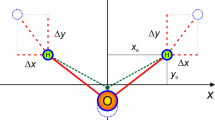Abstract
IT is well known that if the positions of the most intense (v′, v″) bands of a diatomic molecular spectrum are indicated on the usual Deslandres diagram the axes of which are the upper (v′) and the lower (v″) quantum numbers involved, then the set of points (v′, v″) so plotted trace out a set of nested, open-limbed curves called the primary and subsidiary Condon loci, some aspects of the geometry of which have been previously discussed1,2. In particular, it was suggested2 that the position of the primary locus could be predicted from a consideration of those vibrational wave functions for which two respective antinodes are located at the same internuclear separation r. It was further suggested that the subsidiary loci could be located from a similar consideration of those wave functions for which one primary antinode and one appropriate subsidiary antinode, respectively, lie at the same value of r. These criteria ensure significant overlap between the two wave functions and thus a relatively large value of the Franck–Condon factor (square of the vibrational wave function overlap integral) which controls all transition probability and intensity parameters of the band.
This is a preview of subscription content, access via your institution
Access options
Subscribe to this journal
Receive 51 print issues and online access
$199.00 per year
only $3.90 per issue
Buy this article
- Purchase on Springer Link
- Instant access to full article PDF
Prices may be subject to local taxes which are calculated during checkout
Similar content being viewed by others
References
Nicholls, R. W., Nature, 193, 966 (1962).
Nicholls, R. W., Nature, 199, 794 (1963).
Murty, M., thesis, Univ. Western Ontario (1966).
Pillow, M. E., Proc. Phys. Soc., 62 A, 237 (1964).
Aiken, H. H., Harvard Problem Rep. No. 27 (1949).
Nicholls, R. W., J. Quant. Spect. and Rad. Trans., 5, 647 (1965).
Author information
Authors and Affiliations
Rights and permissions
About this article
Cite this article
MURTY, M., NICHOLLS, R. Geometry of Condon Loci of Molecular Spectra. Nature 213, 1009–1010 (1967). https://doi.org/10.1038/2131009a0
Issue Date:
DOI: https://doi.org/10.1038/2131009a0
This article is cited by
-
Matrix Property of Vibrational Overlap Integrals
Nature (1968)
Comments
By submitting a comment you agree to abide by our Terms and Community Guidelines. If you find something abusive or that does not comply with our terms or guidelines please flag it as inappropriate.



